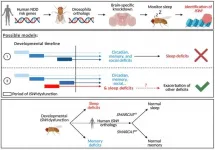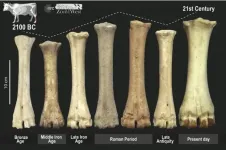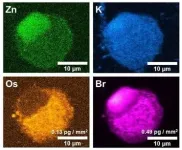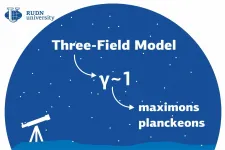(Press-News.org) Lakes underneath the Antarctic ice sheet could be more hospitable than previously thought, allowing them to host more microbial life.
This is the finding of a new study that could help researchers determine the best spots to search for microbes that could be unique to the region, having been isolated and evolving alone for millions of years. The work could even provide insights into similar lakes beneath the surfaces of icy moons orbiting Jupiter and Saturn, and the southern ice cap on Mars.
Lakes can form beneath the thick ice sheet of Antarctica where the weight of ice causes immense pressure at the base, lowering the melting point of ice. This, coupled with gentle heating from rocks below and the insulation provided by the ice from the cold air above, allows pools of liquid water to accumulate.
More than 400 of these 'subglacial' lakes have been discovered beneath the Antarctic ice sheet, many of which have been isolated from each other and the atmosphere for millions of years.
This means that any life in these lakes could be just as ancient, providing insights into how life might adapt and evolve under persistent extreme cold conditions, which have occurred previously in Earth's history.
Expeditions have successfully drilled into two small subglacial lakes at the edge of the ice sheet, where water can rapidly flow in or out. These investigations revealed microbial life beneath the ice, but whether larger lakes isolated beneath the central ice sheet contain and sustain life remains an open question.
Now, in a study published today in Science Advances, researchers from Imperial College London, the University of Lyon and the British Antarctic Survey have shown subglacial lakes may be more hospitable than they first appear.
As they have no access to sunlight, microbes in these environments do not gain energy through photosynthesis, but by processing chemicals. These are concentrated in sediments on the lake beds, where life is thought to be most likely.
However, for life to be more widespread, and therefore easier to sample and detect, the water in the lake must be mixed - must move around - so that sediments, nutrients and oxygen can be more evenly distributed.
In lakes on the surface of the Earth, this mixing is caused by the wind and by heating from the sun, causing convection currents. As neither of these can act on subglacial lakes, it could be assumed there is no mixing.
However, the team behind the new study found that another source of heat is sufficient to cause convection currents in most subglacial lakes. The heat is geothermal: rising from the interior of the Earth and generated by the combination of heat left over from the formation of the planet and the decay of radioactive elements.
The researchers calculated that this heat can stimulate convection currents in subglacial lakes that suspend small particles of sediment and move oxygen around, allowing more of the water body to be hospitable to life.
Lead researcher Dr Louis Couston, from the University of Lyon and the British Antarctic Survey said: "The water in lakes isolated under the Antarctic ice sheet for millions of years is not still and motionless; the flow of water is actually quite dynamic, enough to cause fine sediment to be suspended in the water. With dynamic flow of water, the entire body of water may be habitable, even if more life remains focused on the floors.
"This changes our appreciation of how these habitats work, and how in future we might plan to sample them when their exploration takes place."
The researchers' predictions may soon be tested, as a team from the UK and Chile plan to sample a lake called Lake CECs in the next few years. Samples taken throughout the depth of the lake water will show just where microbial life is found.
The predictions could also be used to generate theories about life elsewhere in the Solar System, as co-author Professor Martin Siegert, Co-Director of the Grantham Institute - Climate Change and Environment at Imperial, explains: "Our eyes now turn to predicting the physical conditions in liquid water reservoirs on icy moons and planets. The physics of subglacial water pockets is similar on Earth and icy moons, but the geophysical setting is quite different, which means that we're working on new models and theories.
"With new missions targeting icy moons and increasing computing capabilities, it's a great time for astrobiology and the search for life beyond the Earth."
INFORMATION:
WASHINGTON --- Recent data reveals that gay men living with HIV report having supportive relationships with family, friends, or in informal relationships rather than with primary romantic partners, while gay men who are HIV negative report having relationships mainly with primary partners. Additionally, gay men living with HIV were more likely to report no primary or secondary supportive partnerships compared to men who are HIV negative. The analysis was led by researchers at Georgetown University Medical Center.
Along with successful HIV treatments, it is known that the presence of social support impacts long-term survival among men living with HIV. However, little has been known about the types of ...
PHILADELPHIA - The mutation of a gene that has been associated with neurodevelopmental disorders like autism spectrum disorder led to marked sleep disturbances in fruit flies, according to a new study from scientists in the Perelman School of Medicine at the University of Pennsylvania. The findings, published Wednesday in Science Advances, provide further evidence that sleep is linked to early neurodevelopmental processes and could guide future treatments for patients.
While sleep disruption is a commonly reported symptom across neurodevelopmental disorders, including autism, it is often treated clinically as a "secondary effect" ...
In ancient European settlements, livestock use was likely primarily determined by political structure and market demands, according to a study published February 17, 2021 in the open-access journal PLOS ONE by Ariadna Nieto-Espinet and colleagues of the Consejo Superior de Investigaciones Científicas, Barcelona.
Zooarchaeology - the study of animal remains from archaeological sites - has great potential to provide information on past human communities. Livestock preferences are known to have changed over time in Europe, but little is known about how much these changes are influenced by environmental, economic, or political conditions of ancient settlements.
In ...
The new method works without extremely high temperatures, is therefore more energy-efficient and has a significantly higher recovery rate (approx. 96 per cent of the starting material) than established processes. These findings will be published on 17 February 2021 in the scientific journal Nature.
Mechanical recycling vs. chemical recycling
"The direct re-utilization of plastics is often hampered by the fact that, in practice, mechanical recycling only functions to a limited degree - because the plastics are contaminated and mixed with additives, which impairs the properties ...
Engineers at the University of California San Diego have created a four-legged soft robot that doesn't need any electronics to work. The robot only needs a constant source of pressurized air for all its functions, including its controls and locomotion systems.
The team, led by Michael T. Tolley, a professor of mechanical engineering at the Jacobs School of Engineering at UC San Diego, details its findings in the Feb. 17, 2021 issue of the journal Science Robotics.
"This work represents a fundamental yet significant step towards fully-autonomous, electronics-free walking robots," said Dylan Drotman, a Ph.D. student in Tolley's research group and the paper's first author.
Applications include low-cost robotics for entertainment, such ...
The unprecedented and deadly blazes that engulfed the American West in 2020 attest to the increasing number, size and severity of wildfires in the region. And while scientists predict the climate crisis will exacerbate this situation, there's still much discussion around its contributing factors.
With this in mind, scientists at five western universities, including UC Santa Barbara, investigated the effects of human-driven climate change and more than a century of fire suppression, which has produced dense forests primed to burn. Their research, published in the journal Environmental ...
In the search for planets capable of sustaining life, an international research team with members from ETH has taken a significant step forward. As the researchers reported recently in the journal Nature Communications, they found signs of a Neptune-sized planet in the Alpha Centauri star system, a mere 4.4 light years away from Earth. This exoplanet is located in a zone that may offer suitable conditions for life. The team was able to collect data with unprecedented sensitivity, thus registering even very weak signals.
Earth is a disruptive factor
Thanks to the new process, the researchers have advanced one step closer to ...
In the paper, 'Tracking Reactions of Asymmetric Organo-Osmium Transfer Hydrogenation Catalysts in Cancer Cells', published in the journal Angewandte Chemie, researchers from the University of Warwick have, for the first time, used the new 185 m beamline to track Osmium in a single cancer cell at a scale of 100 nanometers.
They used two techniques to track potential treatments in cancer cells, the first, ICP-MS, which stands for Inductively Coupled Plasma-Mass Spectrometry, can quantify a wide range of natural and drug elements in millions of cells. However, to investigate a single cancer cell, researchers used synchrotron X-ray Fluorescence ...
Gravity might play a bigger role in the formation of elementary particles than scientists used to believe. A team of physicists from RUDN University obtained some solutions of semi-classical models that describe particle-like waves. They also calculated the ratio between the gravitational interaction of particles and the interaction of their charges. The results of the study were published in the Universe journal.
Due to their small size, the gravitational interaction between elementary particles (electrons, protons, and neutrons) is weak compared to Coulomb forces--attraction ...
Experts say English slang and regional dialect should not be banned from classrooms but when you're getting to grips with a second language how helpful is it to learn non-standard lingo?
Very, says Sascha Stollhans, of the Department of Languages and Cultures at Lancaster University, who argues that standardised language norms are artificial and language learners should learn about all aspects of language, even the controversial ones.
In his policy paper, just published in the Languages, Society & Policy Journal, he says:
There are concerns among professionals that introducing learners to 'non-standard' language could lead to ambiguity and confusion and that students might be penalised for using it in assessments.
Linguistic variation is a rich area of study that can appeal to language ...





